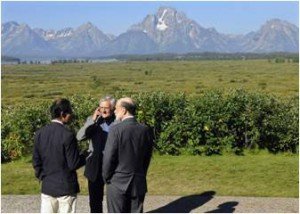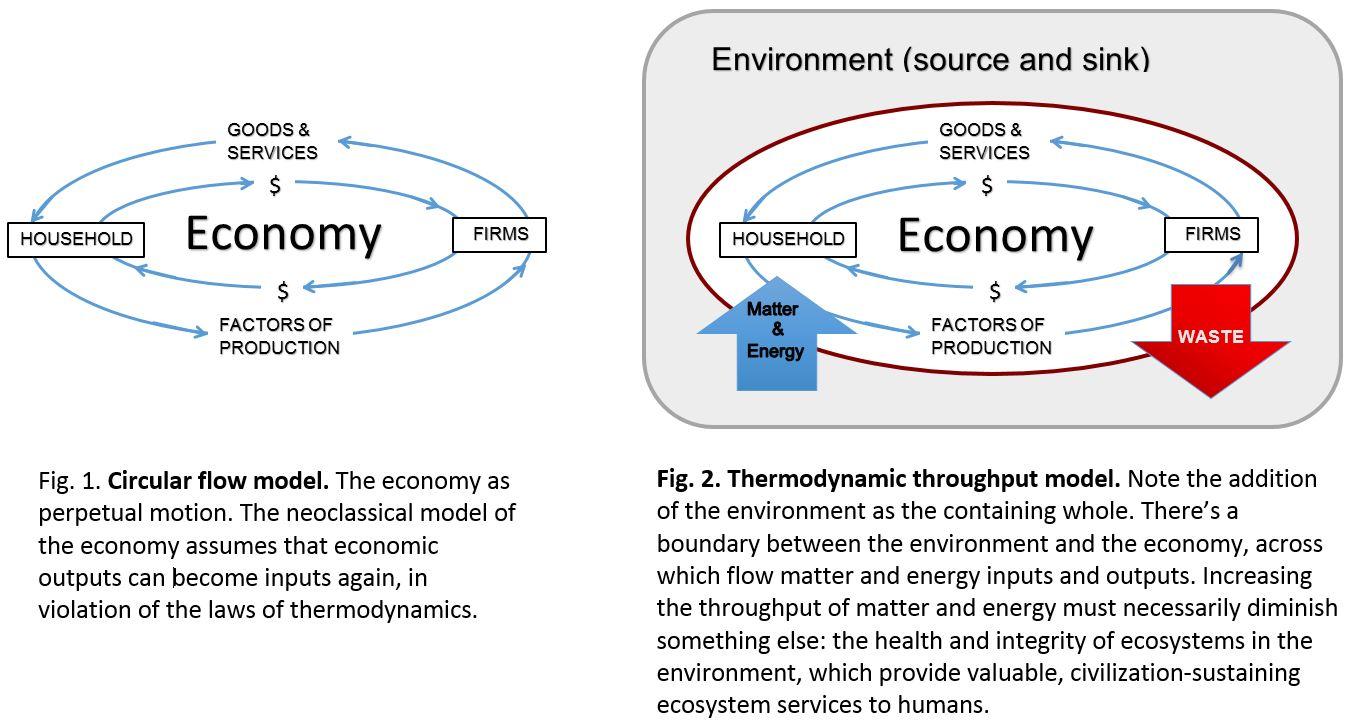Pulsing Paradigm or Steady State?
by Christian Williams
Seldom do you come across arguments that truly question the premise of a steady state economy. Sure, growth-obsessed pundits make arguments against it all the time, but these can typically be refuted by reviewing a few facts. After all, the world is finite, and there are real limits to growth. However, when such an argument arises from the work of the late, great Howard Odum, it’s worth taking a closer look.
Odum — as with Herman Daly — can be considered a genius. Both quite rightly have inspired large groups of disciples. Odum introduced a whole new vocabulary and way of thinking in regard to energy systems and the interactions between civilization, energy, and the environment.[1] One of the concepts that shows up regularly in his work is the “pulsing paradigm.” He asserts that systems of all scales, from the molecular to the galactic, pulse in order to maximize power, and that pulsing systems tend to prevail. He even states that “seeking a constant level of civilization is a false ideal contrary to energy laws… In the long run there is no steady state.” [1, p. 54]
These are worrying words for any devotee of the concept of a steady state economy, and coming from Odum, they can’t simply be dismissed as the ramblings of a lunatic. But before we abandon our quest and run to pitch our tents in the growth-at-all-costs camp, let’s see if the seemingly conflicting notions of the pulse and the steady state can be compatible.
Turning to Daly, we can first ask, how steady is a steady state? The answer should be: steady enough for stability, but not without room for fluctuation. Daly talks of “boundary-oriented stability” [2, p. 53]. Rather than setting a specific point-goal for the economy’s size, we should establish boundaries, and allow fluctuations within them — small pulses perhaps. Admittedly such small fluctuations don’t seem to be on the scale of the pulse that Odum describes (e.g., the rise and fall of a civilization).
Pulses develop from the accumulation of energy or resources over a long period, leading to a short period of frenzied consumption and climax, followed by descent. In modern society, fossil fuels have given rise to our current global-scale pulse. Certainly, there is much to indicate that we may have a period of descent ahead of us, but a period of descent doesn’t rule out the possibility of subsequently establishing a steady state economy.
In fact many of the policies that Odum recommends for this day and age are very similar to those promoted for a steady state economy [1, pp. 388-391]. They include limits on inequality and income, a stable money supply, low fertility rates, a focus on maintenance, and looser restrictions on knowledge and information.
An important question is whether human consciousness can overcome such natural pulses. Odum saw pulses as a mechanism for maximizing power over the long term. He drew on earlier work of Alfred Lotka who also noted the pulsing nature of predator-prey relationships. It seems that pulsing is an evolutionary survival strategy. Yet these systems are not conscious, or if they are (such as with animals), they are not self-aware.
Maybe humanity’s trait of self-awareness could grant us more control. Instead of being trapped in a frenzy of consumption, perhaps we can intentionally restrain ourselves, and store some energy for later use, thus dampening the pulse to a manageable scale. So far it would appear we have been unsuccessful, as we continue to extract and consume energy as quickly as we can. But perhaps a higher level of energy consciousness can be achieved in the future. The implication of this reasoning for steady state economics is that restricting our supply of fossil energy should be of the highest priority — hardly a new idea.
A final insight from Odum relates to the value of information. Like the physical infrastructure of a modern economy, the development of information requires high-quality energy inputs. With a contracting energy supply, society’s store of and access to information will likely diminish. Again, like infrastructure (or any asset), it requires continual maintenance, and information that is not deemed valuable enough will be lost. A long-term objective for steady state economics is to ensure that valuable knowledge survives any period of descent and remains widely available for use in the distant future. In this respect, we can all play our part to keep the flame alive.
[1] Odum, Howard T 2007; Environment, Power, and Society for the Twenty-First Century. Columbia University Press, New York.
[2] Daly, Herman 1991; Steady-State Economics, 2nd edition. Island Press, Washington, DC.
—
Christian Williams has a Master’s degree in sustainable development from Uppsala University (Sweden). His thesis focused on the shorter work week as part of a transition towards a steady state economy, including a case study and political analysis from New Zealand, where he now makes his home.




 "General Audience with Pope Francis" by Catholic Church (England and Wales) is licensed under CC BY-NC-SA 2.0
"General Audience with Pope Francis" by Catholic Church (England and Wales) is licensed under CC BY-NC-SA 2.0

The mistake starts with the fact that “steady state” is intrinsically attached to GDP. When and if, finally, humanity starts to measure things differently the “steady state” concept vanishes.
So, don’t worry with the pulsing paradigme. It’s an iteresting theory that might help mankind. Anyhow, GDP and “steady state” apart, in any situation, if the pulse is too intense the ballon will explode.
If one looks at real GDP per capita for Japan, the EU, and US, Japan has been in a “steady-state” condition for over two decades, whereas the EU and US are well into the second decade of “steady-state” (un)economic conditions.
Global crude oil extraction per capita is similarly in a “steady-state” condition, if not in decline since 2005.
Global oil exports per capita from oil-producing countries are in decline.
Under these “steady-state” conditions resulting from the “end of growth”, and thus the end of capitalism, growth is no longer the critical issue; rather, more equitable, energy efficient, sustainable distribution of income and purchasing power per capita is now required from what is produced.
Plant the SEED = Sustainability, Efficiency, and Equitable Distribution.
I’m rather surprised that the work of Buzz Holling hasn’t been mentioned. “Panarchy” (“ruler of everything”) theory posits that all systems, from sub-atomic particles to galaxy clusters, go through a cycle of increasing energy density and interconnectedness, followed by a decline to a state of low energy and connectedness.
“…He drew on earlier work of Alfred Lotka who also noted the pulsing nature of predator-prey relationships. It seems that pulsing is an evolutionary survival strategy.”
Begs the question…..who is instigating the pulsing and who is benefiting? From a marxist perspective and in light of continuing growth in income inequality……well I think you see my point…
Hej Chistian Williams,
Eventually, Gregory Bateson could add something in answer to the questions you put in the article.
In his “Mind and nature – a necessary unity,” Dutton, New York 1979, he says, that all societies must be both static and dynamic. Too much dynamics rip societies and human beings apart. Too much statics make adaption impossible.
We have placed all our dynamics within material growth. (Follow the real and the financial flows of money.) While within the fields of culure, social life, psychology, [deep] religion, and – here, I add – friluftsliv (Scandinavian, outdoor life), we are static. And suffer.
Our task is now to let economy be static – Daly writes about slowing down the rate of extraction of natural resources by rising the quality of what we must consume – while we explore and expand the fields of culture, social life, psychology, deep religion, and outdoor life. Endlessly…
Within the classic political economy, one krona/dollar gained from production of a thing or a (immaterial) service are equal.
I´m not sure if Bateson’s reasoning is mediating between steady state and pulsing economy, or it it is a third factor.
Cheers, Björn Lindgren
Vassmolösa, Sweden.
—
There is little evidence of any kind of ‘natural’ pulsing in the history of Europe over the past almost 2000 years. The development spurt experienced in the past 200 years is entirely based on the discovering of cheap and later almost free energy (such as the 50,000 : 1 return on capital for energy from sweet crude in the Arabian peninsula.
Such almost free and almost unlimited resource is bound to lead to enormous development and could have led to a truly rich and equal, satisfying society. Unfortunately we have allowed two trends to develop, which will lead to the compete destruction of the current civilisation, steady state or not. These are
1. Massive growth in population, leading to a biological overshoot and collapse.
2. Massive growth in consumption driven by the unrestrained capitalist system, which thrives on innovation and never ending pursuit of ever increasingly resource hungry activities
The first of these is a simple biological overshoot as potentially present in most animal environments, where resource limitations are temporarily removed, leading to rapid population expansion, leading to exhaustion of those resources (usually food), leading to mass starvation and correction to normal numbers.
The second further exaggerates the first trend but also qualitatively increases our dependence on cheap energy, such that we are no longer, in any practical sense, able to go back to energy consumption per capita normal before the current development spurt.
Humanity had a fantastic chance to really achieve something when we discovered this almost free energy. But it would have required great deal of self restrained, which we, as a species, sadly lack.
Had we restrained our numbers to those in the 19th or 18th century, our current problems would have been almost an order of magnitude smaller and more manageable.
Had we restrained our conspicuous consumption and instead realise that fossil fuels were just a short term energy spike, we could have invested most of that energy into research and development in order to find and develop a truly inexhaustible energy source, which could have helped us design a lifestyle for our species of our own choosing.
As it is, once our current civilisation collapses, as it inevitable must, that will be the end of all advanced/ technological civilisations on this planet. That is because we will have already wasted the once only endowment of this almost free energy and indeed most other minerals and materials. And so no future civilisation will be able to repeat the experiment, which we have just messed up.
That of course means that the flower power of the sixties really was the high point of all civilisations on this planet! What a sad indictment of the human species.